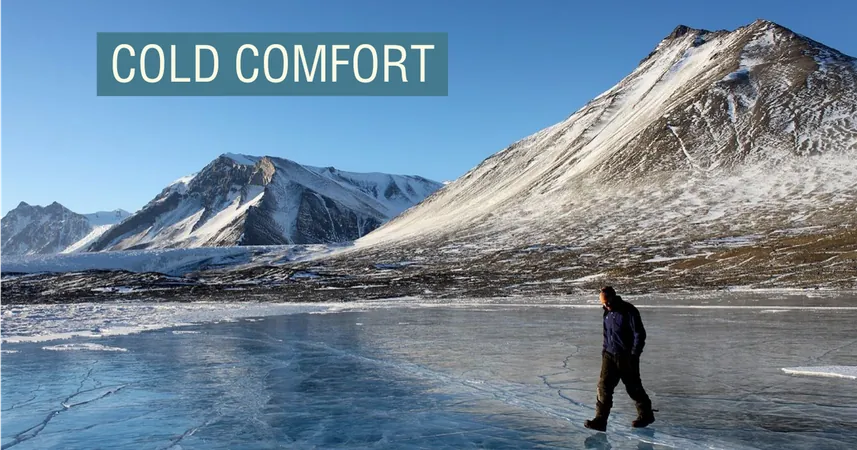
Unlocking the Secrets of Snow: How Arctic Research Could Alter Our Understanding of Climate Change
2024-12-20
Author: Emma
Unlocking the Secrets of Snow: How Arctic Research Could Alter Our Understanding of Climate Change
Researchers from the European Union have ventured into the harsh, icy expanse of the Arctic to uncover the fundamental role that snow plays in Earth's climate system. With temperatures plummeting to an extreme -30°C and enduring up to 24 hours of darkness each day, the team immersed themselves in this frigid environment for a grueling nine-month study.
Describing their surroundings, Dr. Marie Dumont, a prominent snow expert, referred to the region around Cambridge Bay, known locally as Iqaluktuuttiaq, as “very white, vast, and cold.” The conditions were so severe that at one point, they experienced chilling temperatures as low as -50°C. Dumont’s involvement is part of a larger six-year initiative, the IVORI project, which seeks to advance our understanding of snow, glaciers, ice sheets, and permafrost until its anticipated conclusion in 2027.
Why Snow Matters
Snow is not just a winter blanket; it is a vital component of the Earth’s climate system. According to Dumont, there are three primary ways in which snow influences our climate:
1. Solar Reflection: Snow’s bright surface reflects solar radiation, which helps regulate Earth’s temperature.
2. Insulation Properties: The composition of snow—being a mix of ice and air—provides exceptional insulating qualities, safeguarding the ground from rising temperatures.
3. Impact on the Water Cycle: The melting of snow significantly affects the natural water cycles, influencing everything from groundwater levels to river flows.
Despite its importance, researchers admit that many aspects of snow remain poorly understood. Pascal Hagenmuller, a specialist in snow mechanics and avalanche studies, noted, “Everyone feels that they understand snow, but we actually know very little about it.” This lack of understanding extends even to basic phenomena related to snow's behavior, such as the sounds it makes under pressure, which remain mysterious to scientists.
The Unique Nature of Arctic Snow
Contrary to popular belief, not all snow is created equal. The team emphasized that snow in the Arctic behaves differently than what researchers have observed in Alpine regions, despite the latter often receiving more scholarly attention. As Dumont pointed out, “We know a bit about how to model snow in the Alpine regions, but we don’t know much about the snow in the Arctic Circle, even though this snowpack is much more important for the global climate.”
An integral part of the IVORI project is the development of a universal numerical model to represent the evolution of snow all over the world, taking into account its many physical variables. Hagenmuller elaborated on the significance of snow microstructure, stating, "The snow microstructure is the 3D arrangement of ice and air, determining its mechanical stability and insulation properties."
The researchers conducted two field campaigns, one in the French Alps and the other at the Canadian High Arctic Research Station, utilizing advanced technologies such as tomographs to analyze snow samples daily.
Indigenous Communities and Climate Change
Through their research, the scientists became acutely aware of how climate change drastically affects indigenous communities in the Arctic, who engage with snow in ways that people in Europe might not comprehend. Dr. Dumont illustrated the plight of the locals, who traditionally relied on sea ice for winter travel but are now faced with melting ice that renders such journeys unsafe.
The rapid changes in the Arctic landscape threaten the structures built on melting permafrost, creating a precarious situation for residents. "It’s a constant reminder of the importance of our research and the real-world implications it has on human lives," Dumont reflected.
The Broader Climate Picture
The findings from the IVORI project extend far beyond academic interest; they could ultimately reshape climate prediction models. As Hagenmuller pointed out, snow is a crucial element of the climate system, and overlooking its implications could lead to significant forecasting errors.
Dumont believes that advancements in snow research will enhance hydrological forecasts, predict permafrost changes, and provide new insights into avalanche risks. "With more accurate projections, we can better adapt to our changing world," she stated.
As scientists strive to unravel the mysteries of snow and its relationship with our climate, Dumont holds onto her childhood fascination: “Snow transforms the world into something magical and beautiful. Our goal is to preserve that magic for future generations.”
With research like that of IVORI, there is hope not only for better understanding but also for proactive approaches to climate change that could safeguard the irreplaceable beauty of our planet.









 Brasil (PT)
Brasil (PT)
 Canada (EN)
Canada (EN)
 Chile (ES)
Chile (ES)
 España (ES)
España (ES)
 France (FR)
France (FR)
 Hong Kong (EN)
Hong Kong (EN)
 Italia (IT)
Italia (IT)
 日本 (JA)
日本 (JA)
 Magyarország (HU)
Magyarország (HU)
 Norge (NO)
Norge (NO)
 Polska (PL)
Polska (PL)
 Schweiz (DE)
Schweiz (DE)
 Singapore (EN)
Singapore (EN)
 Sverige (SV)
Sverige (SV)
 Suomi (FI)
Suomi (FI)
 Türkiye (TR)
Türkiye (TR)